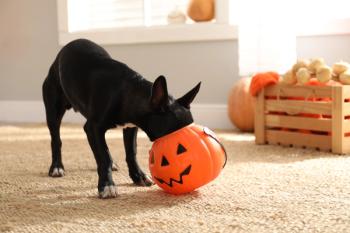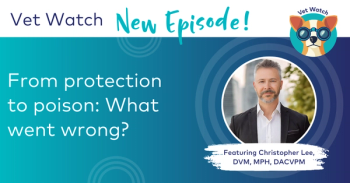The holidays bring great joy and precious time spent with loved ones including family, friends, and beloved companion animals. However, this season is also notorious for bringing a surge of calls to the clinic regarding pets harmed by festive items. Here is a list of some of the most common hazards clients should be aware of during the holidays.
Prepare for an incident
According to the American Veterinary Medical Association,1 it is important clients are prepared before an incident involving toxins or hazards occurs by doing the following:
- Knowing the route to their 24/7 emergency veterinary clinic
- Keeping these numbers in an easily accessible location in case of emergency:
- Their veterinary clinic’s phone number
- Their 24/7 emergency clinic’s phone number
- The ASPCA Poison Control Hotline number (1-888-426-4435)
Decoration hazards
Although ornate decor around the home makes it appear cozy and cheerful, ensure clients keep these items out of reach because they can be dangerous to pets:
- Christmas trees and water additives: Trees can fall over if pets attempt to climb them or play with the decorations. The American Veterinary Medical Association1 (AVMA) advises tying trees to the ceiling or a doorframe using fishing line. Plus, they suggest not adding aspirin, sugar, or anything to the tree’s water that can cause stomach upset for pets.
- Appealing decorations: Items to keep out of reach include tinsel, ornaments, potpourris and more. Pets may eat tinsel out of curiosity, which can cause intestinal blockages. Broken ornaments may cause injuries and, if ingested, could cause intestinal blockage or toxicity. Homemade ornaments, especially those made from salt dough or other food-based materials, could be enticing and pose a threat. Liquid potpourris contain essential oils and cationic detergents that may harm a pet’s skin, eyes, and mouth; solid potpourris can cause complications if consumed.
- Candles and electric lights: Lights can cause burns or injuries if a pet chews the cord. The AVMA1 recommends never leaving pets alone in a room with a burning candle because this can cause a fire.
- Festive flowers and plants: Tell clients to familiarize themselves with plants that are harmful or poisonous to pets such as amaryllis, mistletoe, balsam, pine, cedar, and holly. They can view the American Society for the Prevention of Cruelty to Animals’ (ASPCA) lists of plants toxic to dogs and cats at the following links: https://www.aspca.org/pet-care/animal-poison-control/dogs-plant-list and https://www.aspca.org/pet-care/animal-poison-control/cats-plant-list
Symptoms a pet has ingested a toxic item
If clients suspect their pet is poisoned or ate a hazardous food, they should call the veterinary clinic, 24/7 emergency clinic, or ASPCA Poison Control Hotline immediately. Signs of this include2:
- Gastrointestinal symptoms (ie, vomiting, diarrhea, drooling/hypersalivating, inappetence, nausea)
- Internal bleeding (ie, coughing blood, vomiting blood, pale gums, racing heart rate, weakness or lethargy, collapse)
- Kidney failure (ie, halitosis, inappetence, vomiting, diarrhea, excessive thirst or urination, absence of or decrease in urine)
- Liver failure (ie, jaundice, weakness or collapse secondary to a low blood sugar, dull mentation/acting abnormally, vomiting, diarrhea, melena)
Food hazards
The holidays are often associated with a plethora of home-cooked meals, sweets, and treats. Discover the foods of the season that may pose threats to pets:
- Chocolate and baked goods: It is a given that chocolate should be off-limits to pets, but it is important clients be more mindful of this because this delicacy is more prevalent around the house during the holidays. Desserts should be out of reach as well, because they are often too rich for pets, which can cause stomach upset, and they often contain xylitol—an artificial sweetener—that has been found to cause liver failure and even death in dogs.
- Fat trimmings and bones: Fat trimmings from meat (cooked or uncooked) can cause pancreatitis. Clients should know that although dogs are known to enjoy bones, they can cause choking or can splinter, causing digestive complications.
- Yeast dough: This can cause painful gas and possibly dangerous bloating.
- Other toxic foods: For more toxic foods clients may be cooking this season, direct them to the ASPCA’s entire list of foods toxic to pets: https://www.aspca.org/pet-care/animal-poison-control/people-foods-avoid-feeding-your-pets
Takeaways
You can advise clients of these common holiday hazards by posting signs around the clinic, making printouts, or educating them over the phone or in person. It will make a significant difference that their furry companions stay safe during the most wonderful time of the year.
References
- Winter holiday pet safety. American Veterinary Medical Association. Accessed October 22, 2021. https://www.avma.org/resources-tools/pet-owners/petcare/holiday-pet-safety
- Know the signs of poisoning in dogs and cats. Pet Poison Helpline. Accessed October 22, 2021. https://www.petpoisonhelpline.com/pet-owners/basics/signs-of-poisoning-in-dogs-and-cats/







